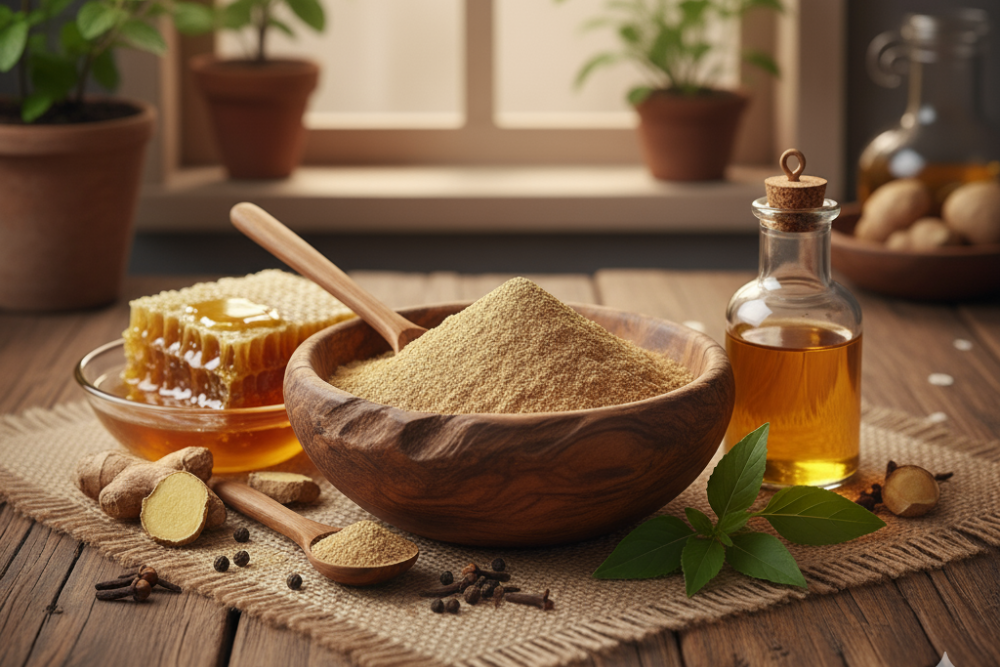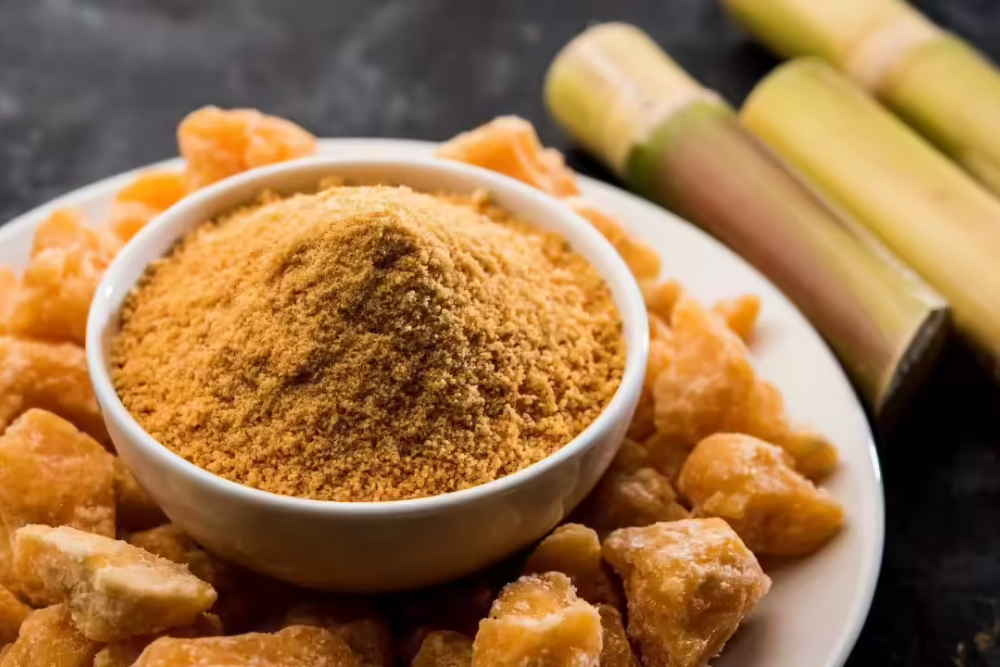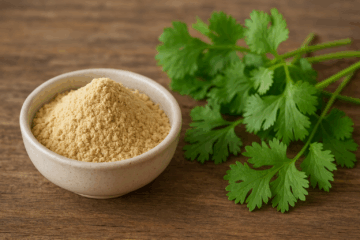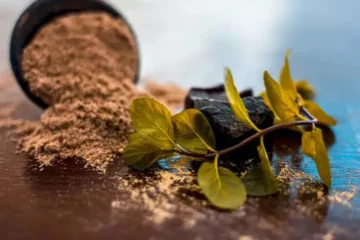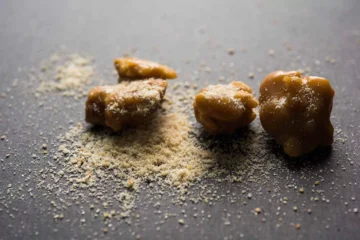1. Why is hing considered a must-have winter spice — what makes it more beneficial in cold weather?
Short Answer :
Hing is a must-have winter spice because it aids digestion, boosts circulation, and supports immunity. Its warming nature helps counter cold weather sluggishness, making it perfect for heavy winter meals.
Long Answer :
Hing (asafoetida) is one of the best winter spices for digestion and warmth. In winter, our metabolism slows down, and we often consume richer, heavier foods that can cause gas and bloating. Hing’s natural heat-promoting qualities stimulate digestive enzymes and improve circulation.
Here’s why hing tops the list of Ayurvedic winter spices:
- Supports digestion: Activates gastric juices and prevents bloating after heavy meals.
- Improves blood flow: Its warming nature enhances circulation, keeping the body active.
- Boosts immunity: Hing’s antimicrobial properties strengthen resistance against winter colds and infections.
- Balances doshas: Ayurveda suggests hing balances Vata and Kapha, which dominate cold months.
2. How does hing compare to other winter spices like ginger, cinnamon, or ajwain — when should I use it instead?
Short Answer :
While ginger and cinnamon are warming, hing is uniquely digestive. Use hing instead when you need quick relief from bloating or indigestion, especially after rich, oily winter meals.
Long Answer :
Each winter spice plays a unique role, but hing stands out as a digestive stimulant and anti-bloating agent. Below is a comparison table showing how hing differs from other traditional Indian winter spices:
| Spice | Primary Benefit | Best Used For | When to Prefer Hing |
|---|---|---|---|
| Hing (Asafoetida) | Anti-bloating, Digestive aid | Hearty curries, lentils, soups | After heavy meals or with gas-causing foods |
| Ginger | Anti-inflammatory, Warming | Teas, soups, and stir-fries | Use hing if bloating or heaviness occurs |
| Cinnamon | Sweet warmth, Blood sugar control | Drinks, desserts, stews | Hing is better for savory or spicy dishes |
| Ajwain | Carminative, Gas relief | Breads, digestive tonics | Hing complements ajwain for deeper relief |
So, while cinnamon and ginger offer warmth, hing’s specialty lies in easing post-meal heaviness and balancing gut health — making it essential in winter foods with hing.
3. What are some easy ways to use hing in winter meals — can I add it to soups, dals, or teas?
Short Answer :
Yes! You can use hing in soups, dals, teas, or veggie dishes. Temper it in ghee, sprinkle over cooked lentils, or mix a pinch in warm water for a natural winter tonic.
Long Answer :
Hing is versatile and can be added to almost any winter dish for both flavor and health. Here are easy ways to include hing spice benefits in your winter kitchen:
- In Soups: Add a pinch of hing to hot oil before sautéing vegetables for rich aroma and digestion support.
- In Dals: Temper hing in ghee with cumin and mustard seeds before pouring it over cooked lentils.
- In Teas: Mix a small pinch of hing with ginger and honey in warm water for immunity and digestion.
- In Stir-Fries: Add hing to winter vegetables like cabbage, spinach, or cauliflower for better flavor absorption.
- In Curries: Combine hing with turmeric and ajwain for a strong anti-bloating effect.
These uses make hing one of the best spices for winter — simple, practical, and beneficial.
4. Can hing help with winter digestion issues like gas, heaviness, or sluggish metabolism?
Short Answer :
Yes, hing helps relieve winter digestion problems like gas and heaviness by stimulating digestive enzymes and reducing intestinal discomfort naturally.
Long Answer :
Many experience bloating or indigestion during winter due to slower metabolism and heavy foods. Hing works as a natural digestive stimulant that improves gut motility and enzyme activity.
Here’s how hing for cold and digestion helps:
- Prevents gas formation: Its volatile oils reduce gas buildup and ease flatulence.
- Enhances metabolism: Hing’s warming quality boosts sluggish winter digestion.
- Reduces heaviness: It breaks down fats and proteins efficiently, preventing post-meal discomfort.
- Balances the gut microbiome: Hing has mild antibacterial action, reducing harmful gut bacteria.
Regular use in meals, teas, or warm water can offer visible relief, making it one of the top winter spices for digestion.
5. Is hing safe for everyone — how much should I use, and are there any side effects in winter diets?
Short Answer :
Yes, hing is safe in small amounts — about a pinch per meal. Overuse may cause throat irritation or acidity. Always mix it with ghee or oil before adding to food.
Long Answer :
Hing is powerful, and a little goes a long way. When used correctly, it’s safe for most people and enhances winter wellness. However, moderation is key. Here are guidelines:
- Recommended amount: 1/4 teaspoon (a pinch) per meal is sufficient.
- Usage tip: Always fry hing briefly in ghee or oil to mellow its strong aroma and improve absorption.
- Allergy caution: Those with high acidity, ulcers, or pregnancy should consult a doctor before regular use.
- Combination use: Pair hing with other Ayurvedic winter spices like cumin or turmeric for balanced effects.
Following these tips ensures you gain all hing benefits in winter without irritation or side effects.
Conclusion
Short Summary :
Hing is a winter essential that aids digestion, boosts immunity, and adds warmth. Its unique Ayurvedic benefits make it the hero of all winter spices with hing recipes.
Detailed Conclusion :
When it comes to traditional Indian winter spices, hing easily takes the lead. Its ability to combat cold-induced sluggishness, improve digestion, and enhance circulation makes it an unmatched kitchen essential. Whether you sprinkle it over dals, temper it in ghee, or mix it in teas, hing supports your body naturally during winter.
For those seeking balance between taste and health, hing perfectly embodies the wisdom of Ayurveda — keeping you warm, light, and active through the chilly months. This winter, let your kitchen embrace the power of winter spices with hing.
